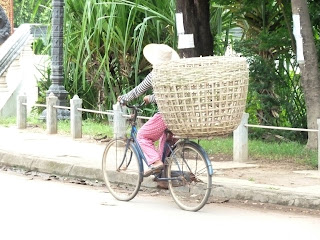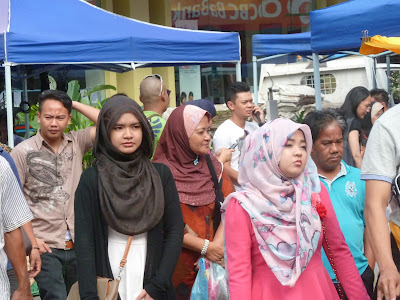Deja vu! Angkor Wat or Chichen Itza?

Fascinating how so many cultures rose to great heights, with
hundreds of thousands of constituents and remarkable technological advances –
only to fairly abruptly abandon those complex societies and vanish from the face
of the earth.
 Somehow I thought Angkor Wat would be one of a kind, but it
immediately reminded me of temples and
architecture half a planet away in current day Mexico – the grand pyramid of
Chichen Itza in the Yucatan. The heat
was as tropical and the flora thriving there was similar – bougainvilla and
hibiscus in a mass of overpowering jungle.
The major temples both sit in a grand landscape - with ball fields and
astronomical buildings in one, and libraries and altars in the other. Both have snakes entwined on their structures - the cobra, and the rattlesnake.
Somehow I thought Angkor Wat would be one of a kind, but it
immediately reminded me of temples and
architecture half a planet away in current day Mexico – the grand pyramid of
Chichen Itza in the Yucatan. The heat
was as tropical and the flora thriving there was similar – bougainvilla and
hibiscus in a mass of overpowering jungle.
The major temples both sit in a grand landscape - with ball fields and
astronomical buildings in one, and libraries and altars in the other. Both have snakes entwined on their structures - the cobra, and the rattlesnake.

However, this was a Hindu/Buddhist temple (there are arguments as to who came first, but the toppled heads of the Buddha bespoke a Hindu takeover).

Another type of statue supplanted those of the Buddha as well - the ‘linga’ or phallic statues. Must say when you’ve seen one, you’ve seen them all - apparently you can visit a mountain temple with literally hundreds of massive peni thrusting skyward...I passed.
The earliest temples are dated around 900,
like the one to the right, although the civilization rose in power in the late 1100’s and reached its
zenith in the 1200’s.
Weaving in and out of the ruins, we didn't have time for all 76, and hit the high spots - me with a gleeful grin that seemed permanent.
We arrived at Ta Prohm through the jungle - the back way (Vuttha said that he could park the motorcycle inside the grounds this way - that the tourist police would stop him coming in the front). What a treat! Slipping along the outskirts of the complex was delicious - arriving to this sight. Built in the mid-1200's, the tree seen overtaking the structure is 300 years old!


This place was Magical



This place was Magical

One of the most amazing things to me were the ceilings - how did they get these enormous blocks of stone to form the high ceilings - the blocks resting together, unsupported? Or, for that matter, how did they cut the blocks so perfectly that they rested together seamlessly...
And then we were on through the magnificent gates of Angkor Thom to the faces of Bayon.
And then we were on through the magnificent gates of Angkor Thom to the faces of Bayon.
The scale and artistry is Mind-boggling
Just as mind-boggling was Vuttha's cleverness!
Gargantuan Faces!!
And a darling little temple boy
There was one more temple we needed to see before the end of the day - about an hour's trek up the road to Banteay Srei - the women's temple, renowned for it's delicacy.
The intimacy of the courtyards -
and the monkeys - were enchanting
My excellent guide, Dam Vuttha told me that many of the
parchments of early history were stored in the temple libraries and simply turned to dust, and
that the Khmer Rouge also burned historical records of Cambodia in the
1970-1991 'civil war' when intellectuals were slaughtered.
However, there are carvings on some of the temples – especially Banteay Srei ("citadel of the women"), which tell of two major periods – that of the ancient temples (before 1000) and the society of “the greatest king” who commissioned Angkor Wat and the surrounding 76 temples still standing in the UNESCO site, 9km in length.
However, there are carvings on some of the temples – especially Banteay Srei ("citadel of the women"), which tell of two major periods – that of the ancient temples (before 1000) and the society of “the greatest king” who commissioned Angkor Wat and the surrounding 76 temples still standing in the UNESCO site, 9km in length.

 Vuttha also said that there were several reasons postulated
for the abandonment of the civilization, home to an estimated million
people. It seems as though there were
invaders, shown in the friezes in Thom – the Cambodians are shown with long
earlobes driving the Cham out (while we were there, some women from Phnom Penh
asked him some questions and when he showed them Cham – they all said,” Ah
Cham” – I had to google Cham to understand who they were.
Vuttha also said that there were several reasons postulated
for the abandonment of the civilization, home to an estimated million
people. It seems as though there were
invaders, shown in the friezes in Thom – the Cambodians are shown with long
earlobes driving the Cham out (while we were there, some women from Phnom Penh
asked him some questions and when he showed them Cham – they all said,” Ah
Cham” – I had to google Cham to understand who they were. I hope that the current education system in the US does a better job now than when I grew up – in total ignorance of Southeast Asian cultures. Vuttha said that the civilization got so big that water became a problem – and that people began dispersing to other parts of Cambodia.
The next time I visit, I will have done more reading on the area, and ask Vuttha to school me more.
With major appreciation to Vuttha - a very special person.






































































